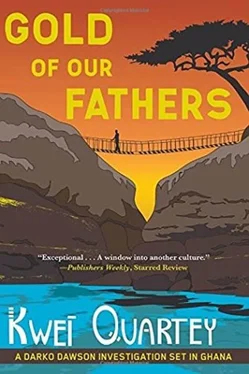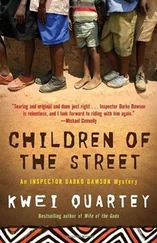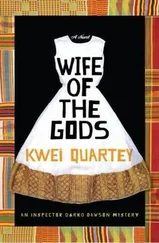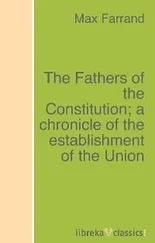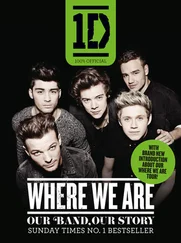A chill went down Dawson’s spine. Covered in clumps of soil, the dead man was clothed except for his shoes. His back was arched concavely. His legs pulled up backward to meet his wrists behind him. His head strained upward with his eyes open and mouth agape, as if he had been in a desperate struggle to escape this terrible, anatomically impossible pose. Moving a little closer, Dawson saw that the ankles and wrists were free of ligatures, but ligature marks were present. The man was no longer tied up. He had gone into rigor in that position. Dawson spotted two slashed, knotted lengths of rope on the ground beside the corpse. Trying to reconstruct events in his mind, he imagined that after the dead man had been discovered, his brother had hastily cut the ligatures away in an effort to “release” the corpse, only to find that the body was fixed the way it had been found.
Dawson’s eyes shifted around the room: food-caked tin plates and pots and pans stacked in one corner, plastic gallon containers in another, and soiled clothes in a third next to a pump-action shotgun-the weapon of choice among miners.
Kobby was looking at the scene with revulsion.
“Do you know the Chinese man’s name?” Dawson whispered to him.
“Which one, sir?”
“Both, I suppose.”
“Please, I don’t know the name of the dead one,” Kobby said, “but the people outside say the brother’s name is Wei.”
“Does he speak English?”
“A little bit.”
Dawson went closer to Wei and kneeled down. “Mr. Wei, my name is Detective Chief Inspector Dawson.”
Wei was a chunky man. He pulled back from Dawson as if he’d been threatened and began shouting. Perhaps he did think Dawson was threatening him. In a moment of confusion, Dawson realized that the Chinese man was speaking in Twi. It was bad, but it was Twi.
“Get away from me!” Wei said. “Look at my brother!”
“Mr. Wei-”
“They kill him!” he said, switching to broken English. “They kill him!”
“Who?” Dawson asked urgently. “Who killed him?”
“Galamsey! Galamsey!”
“Which ones? Who?”
Wei didn’t answer, his crying trailing off abruptly, and only his lower lip trembling as he looked down at his brother. “Oh, Bao. Oh, Bao.”
Bao had been thin, but putrefaction was beginning to bloat him. Tropical weather never treats corpses kindly. Dawson would need to talk to Wei a lot more very soon, but he was too distraught to get any useful answers out of him at the moment. For now, he needed to get the man away from his dead brother Bao.
Dawson stood up again and spoke quietly to Inspector Sackie. “Is a crime scene unit available?”
He looked skeptical. “There is one in Kumasi, but they have to cover so many places in the region. We can call them, but usually they cannot arrive for twelve hours or more.”
That didn’t surprise Dawson, as bad as it seemed. CSUs were hard to come by in smaller towns and villages. Dawson made a decision. Forget the CSU. He could not allow the corpse to stay here for several hours.
“Let’s get the body to Komfo Anokye morgue as soon as possible,” he said.
Komfo Anokye Teaching Hospital, often called KATH , was Kumasi’s largest.
“We can get a four-by-four to transport it there,” Sackie said, taking out his phone to make a call.
“Thank you,” Dawson said, studying Wei for a moment and trying to decide the best way to handle this. He returned to the Chinese man’s side. “We are going to take care of your brother, okay, sir?”
“Wha’?”
“We are going to take him to the hospital for autopsy.” Dawson realized he was speaking louder. How ridiculous.
Wei shook his head, and Dawson wasn’t sure that he really understood. Getting to his feet, he touched Wei’s arm softly and indicated that he should follow his lead.
“Come on, my friend. Let’s go now.”
He stayed stubbornly where he was. Kobby came to Dawson’s aid by grasping Wei firmly under one arm and urging him to get to his feet. Abruptly, Wei exploded, lunged at the constable, and took a swing. Kobby sidestepped and deflected the blow, which put the Chinese man off-balance and sent him to the ground in a graceless heap. Dawson, Sackie, and Kobby moved in to cuff him.
“I don’t know what your problem is, my friend,” Dawson said, “but you are under arrest for assaulting a police officer. I wish I knew how to say that in your language.”
Then, Dawson reflected, Wei could even be the culprit. Who knows? All that babbling in Chinese might have been his confession: I killed my brother.
“Take him outside to sit down,” Dawson instructed, breathing heavily. What a way to start the day .
Kobby escorted Wei out as the Chinese man kept shouting something they didn’t understand. Now Dawson and Inspector Sackie were alone with the dead body. No police photographer meant Dawson had to improvise. He took his phone out, backed up, and took a long shot of the corpse and the interior of the shack before moving in. He photographed the ground around the body, including a white plastic bucket containing dirty water and a rag that Wei must have been using to wash his brother’s body, the two lengths of rope on, and a close-up of the knots. It might help determining left- or right-handedness of the killer, but not necessarily.
Dawson looked up at Sackie. “Do you have any specimen bags?”
The inspector shook his head. “No, sir, but I can send someone to get some from the town. Plastic, or paper?”
“Both plastic and paper, please.”
“Yes, sir.”
Sackie went outside, leaving Dawson by himself with the corpse. Dawson saw deep bloody gashes in the top of the scalp and wondered what had inflicted them. Perhaps a machete, probably the most common murder weapon in Ghana. Was that what killed this man?
Dawson picked up a twig and gently lifted the pile of rags and old clothes in case a machete was concealed underneath, but he found nothing. He looked up at the ceiling. Sometimes, people slipped weapons between the beams. Nothing there either.
He didn’t see blood spatter anywhere. If the man had not been bleeding when he was discovered, the wounds might have been inflicted postmortem, but Dawson still had to return to the original crime scene to look for signs of blood before he came to that conclusion. He took a look at the shotgun, examining it for bloodstains without success. He had been thinking that maybe someone hit the Chinese guy on the top of his head with the barrel or stock of the weapon.
He photographed Bao’s head wounds from different angles, both with and without the flash. When he moved his attention to the man’s face, Dawson recoiled. It was a picture of fright, as if he had died screaming. Perhaps in pain as the machete blows were delivered.
Or perhaps he was shrieking in terror as he was tied. Could be two assailants, Dawson reflected, because it was tricky to tie up someone who was struggling-especially in this bizarre position-and Dawson was pretty certain that, if his temper was anything like his brother’s, Wei was fighting at the time of death.
No marks on his belly, which was an odd, mottled grayish-yellow color. At the sides of his trunk closest to the ground, the purplish-red coloration of pooled blood-lividity-suggested the position he had been in after death: on his belly. To confirm, Dawson turned the body, which rolled in one piece, like an artless statue. Yes, there was the blanched, oval section on Bao’s abdomen, where his weight had prevented blood from pooling.
Dawson took photos of all of this, because the lividity would change with time, and if it took a while to get the body to the morgue, which he suspected it would, the corpse would deteriorate in all sorts of other ways.
Читать дальше
